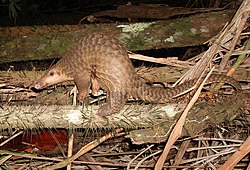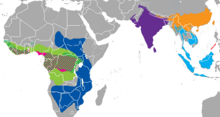| Pangolin Temporal range: Paleocene–Present | |
|---|---|
 | |
| Sunda pangolin (Manis javanica) | |
| Scientific classification | |
| Kingdom: | Animalia |
| Phylum: | Chordata |
| Class: | Mammalia |
| (unranked): | Ferae |
| Order: | Pholidota Weber, 1904 |
| Family: | Manidae Gray, 1821 |
| Genera | |
 | |
| Species ranges
Manis crassicaudata Manis pentadactyla Manis javanica Manis culionensis Phataginus tricuspis Phataginus tetradactyla Smutsia gigantea Smutsia temminckii
| |
Pangolins are mammals of the order Pholidota. ...
Pangolins have large, protective keratin scales covering their skin, and they are the only known mammals with this feature. They live in hollow trees or burrows, depending on the species. Pangolins are nocturnal, and their diet consists of mainly ants and termites which they capture using their long tongues. They tend to be solitary animals, meeting only to mate and produce a litter of one to three offspring which are raised for about two years. Pangolins are threatened by hunting (for their meat and scales) and heavy deforestation of their natural habitats, and are the most trafficked mammals in the world. ... (They)are listed as endangered, and two ... are listed as critically endangered on the International Union for Conservation of Nature Red List of Threatened Species.
Etymology
The name "pangolin" comes from the Malay word pengguling, meaning "one who rolls up". ...
Description
The physical appearance of a pangolin is marked by large, hardened, overlapping plate-like scales, which are soft on newborn pangolins, but harden as the animal matures. They are made of keratin, the same material of which human fingernails and tetrapod claws are made. The pangolin's scaled body is comparable to a pine cone or globe artichoke. It can curl up into a ball when threatened, with its overlapping scales acting as armor, while it protects its face by tucking it under its tail. The scales are sharp, providing extra defense from predators.
Pangolins can also emit a noxious-smelling chemical from glands near the anus, similar to the spray of a skunk. They have short legs, with sharp claws which they use for burrowing into termite and ant mounds, as well as climbing.
The tongues of pangolins are extremely long like those of the giant anteater and the tube-lipped nectar bat; the root of the tongue is not attached to their hyoid bone, but is located in the thorax between the sternum and the trachea. ...
Behavior
Most pangolins are nocturnal animals that use their well-developed sense of smell to find insects. The long-tailed pangolin is also active by day, while other species of pangolins spend most of the daytime sleeping, curled up into a ball.[10]
Arboreal pangolins live in hollow trees, whereas the ground-dwelling species dig tunnels underground, to a depth of 3.5 m (11 ft).
Some pangolins walk with their front claws bent under the foot pad, although they use the entire foot pad on their rear limbs. Furthermore, some exhibit a bipedal stance for some behaviors and may walk a few steps bipedally. Pangolins are also good swimmers.
Diet
Pangolins are insectivorous. Most of their diet consists of various species of ants and termites and may be supplemented by other insects, especially larvae. They are somewhat particular and tend to consume only one or two species of insects, even when many species are available to them. A pangolin can consume 140 to 200 g (4.9 to 7.1 oz) of insects per day.[12]
Pangolins have a very poor sense of vision, so they rely heavily on smell and hearing. They use their powerful front claws to dig into trees, ground, and vegetation to find prey, then proceed to use their long tongues to probe inside the insect tunnels and retrieve their prey. Pangolins lack teeth, so also lack the ability to chew; however, while foraging, they ingest small stones which accumulate in their stomachs to help to grind up ants.
Some species, such as the tree pangolin, use their strong, prehensile tails to hang from tree branches and strip away bark from the trunk, exposing insect nests inside.
Reproduction
Pangolins are solitary and meet only to mate. Males are larger than females, weighing up to 40% more. While mating season is defined, they typically mate once each year, usually during the summer or autumn. Rather than the males seeking out the females, males mark their location with urine or feces and the females will find them. If there is competition over a female, the males will use their tails as clubs to fight for the opportunity to mate with her.
Gestation periods differ by species, ranging from roughly 70 to 140 days.[18] African pangolin females usually give birth to a single offspring at a time, but the Asiatic species may give birth from one to three. Weight at birth is 80 to 450 g (2.8 to 15.9 oz) and the average length is 150 mm (5.9 in). At the time of birth, the scales are soft and white. After several days, they harden and darken to resemble those of an adult pangolin. During the vulnerable stage, the mother stays with her offspring in the burrow, nursing it, and wraps her body around it if she senses danger. The young cling to the mother's tail as she moves about, although in burrowing species, they remain in the burrow for the first two to four weeks of life. At one month, they first leave the burrow riding on the mother's back. Weaning takes place around three months of age, at which stage the young begin to eat insects in addition to nursing. At two years of age, the offspring are sexually mature and are abandoned by the mother.
Threats
Pangolins are hunted and eaten in many parts of Africa and are one of the more popular types of bush meat, while local healers use the pangolin as a source of traditional medicine. They are also in great demand in southern China and Vietnam because their meat is considered a delicacy and some believe that pangolin scales have medicinal qualities. Over the past decade, over one million pangolins are believed to have been illegally trafficked, making it the most trafficked animal in the world. This, coupled with deforestation, has led to a large decrease in the numbers of pangolins. Some species, such as Manis pentadactyla have become commercially extinct in certain ranges as a result of overhunting. In November 2010, pangolins were added to the Zoological Society of London's list of genetically distinct and endangered mammals. All eight species of pangolin are classified by the IUCN as threatened to extinction, while two are classified as critically endangered.
Though pangolins are protected by an international ban on their trade, populations have suffered from illegal trafficking due to unfounded beliefs in East Asia that their ground-up scales can stimulate lactation or cure cancer or asthma. In the past decade, numerous seizures of illegally trafficked pangolin and pangolin meat have taken place in Asia. In one such incident in April 2013, 10,000 kg (11 short tons) of pangolin meat were seized from a Chinese vessel that ran aground in the Philippines. In another case in August 2016, an Indonesian man was arrested after police raided his home and found over 650 pangolins in freezers on his property. The same threat is reported in many countries in Africa, especially Nigeria, where the animal is at the verge of extinction due to over exploitation.
Conservation
As a result of increasing threats to pangolins, mainly in the form of illegal, international trade in pangolin skin, scales, and meat, these species have received increasing conservation attention in recent years. For example, in 2014, the IUCN recategorised all eight species of pangolin on its Red List of Threatened Species, and each species is now properly listed as being threatened with extinction.[38] Also, the IUCN SSC Pangolin Specialist Group launched a global action plan to conserve pangolins, dubbed Scaling up Pangolin Conservation in July 2014. This action plan aims to improve all aspects of pangolin conservation with an added emphasis on combating poaching and trafficking of the animal, while educating communities in its importance.
 |
| Chinese pangolin |
Many attempts have been made to reproduce pangolins in captivity, but due to their reliance on wide-ranging habitats and very particular diets, these attempts are often unsuccessful. They are susceptible to diseases such as pneumonia and the development of ulcers in captivity, complications which can lead to an early death. In addition, pangolins rescued from illegal trade often have a higher chance of being infected with parasites such as intestinal worms, further lessening their chance for rehabilitation and reintroduction to the wild. Recently, researchers have been able to improve artificial pangolin habitats to allow for reproduction of pangolins, providing some hope for future reintroduction of these species into their natural habitats.





No comments:
Post a Comment